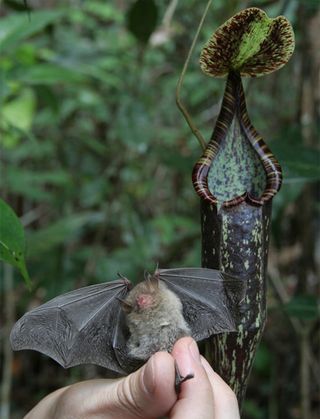Bats Use Carnivorous Pitcher Plant as Living Toilet

Birds may bomb cars with airborne droppings, but apparently bats use living toilets made of carnivorous plants, gracing them with their fecal matter, scientists find.
Pitcher plants get their name from the long jug-like structures they form from rolled-up leaves. These pitchers serve as pitfall traps, with digestive fluids to liquefy any hapless victims (typically insects) that fall in.
Scientists recently discovered that small mammals known as tree shrews on the Southeast Asian island of Borneo don't end up as doomed victims of the carnivorous plant — instead, they sit on the rims of one such pitcher plant Nepenthes lowii and then poop inside.
As ignoble as this might seem, this is a win-win situation for both the pitchers and tree shrews. The plants cover the pitcher lids with nectar that the critters readily lick for nourishment, while the excrement serves as much-needed fertilizer. (This is why carnivorous plants normally trap insects — to get valuable nutrients.)
Now it turns out pitcher plants are not exclusive bathrooms. Scientists have discovered the small woolly bat Kerivoula hardwickii uses a different type of pitcher in Borneo, Nepenthes rafflesiana elongata, as a lavatory and home as well.
Bat roosts
Tropical ecologist Ulmar Grafe at the University of Brunei Darussalam in Brunei first started working on the island of Borneo investigating how tadpoles can survive within the fluid of pitcher plants.
Sign up for the Live Science daily newsletter now
Get the world’s most fascinating discoveries delivered straight to your inbox.
"It was a hot and humid day in the peat swamp forest and a student calls out, 'Ulmar, have a look at this — there's a bat in this pitcher,'" Grafe recalled. "We squeezed it out the top, and it was alive and well, obviously using the pitcher as a daytime roost."
Other people had seen bats roosting in the pitchers but they put it off as coincidental. "We were seeing it too often, however," Grafe said.
The pitchers of N. rafflesiana elongata are actually poor insect traps, capturing up to seven times fewer insects than typical varieties and possessing relatively little in the way of insect-attracting scents and digestive fluid. As such, "maybe the pitchers are modified in a way that attracts bats," Grafe said. "Bat roosting may not be coincidental." [Pitcher Plant Eats Rodents]
To learn more about the relationship between the small woolly bats and the plants, the researchers stuck radio transmitters onto 17 bats they found in pitchers.
"We had to use the lightest, custom-made transmitters possible, weighing only 0.4 grams, probably the smallest ones used to track animals so far, to minimize any effect of transmitter weight on bat behavior — the bats weigh 4 grams on average," Grafe said.
Not only was it tricky gluing transmitters onto the bats, "one of my students was in the peat swamp one day checking the roosts with her mother of all people, and she calls me all excited saying that she doesn't dare check one of the pitchers because a pit viper is perched beside it," Grafe said. "I told her not to worry and in just over an hour I arrived at the site and removed the viper, not wanting to be responsible for any mishap. I took the viper home as a pet, to the enjoyment of my two young kids."
Also, "my students from Germany were living with local hosts nearby who mentioned that bats were quite tasty and also healthy for pregnant women," he added. "Needless to say, we did not let them know where 'our' bats were to be found."
After their hard work, the scientists found these bats exclusively used pitchers of N. rafflesiana elongata as their daytime roosts. During the course of a roughly six-week period in 2009, they saw that 64 plants out of 223 they monitored harbored at least one bat in one of its pitchers.
The pitchers lent ample space for the bats to roost above the digestive fluid — the pitchers of N. rafflesiana elongata are up to four times longer than typical varieties of pitcher plant. Indeed, on two separate occasions, young bats shared the same pitchers with their mothers.
The scientists also compared pitchers of N. rafflesiana elongata that served as roosts and ones that were never occupied, which the researchers had monitored since they opened. They found leaves of roost pitchers had significantly higher levels of the vital nutrient nitrogen, with which excrement is loaded.
Mutually beneficial
As is the case with tree shrews and N. lowii, the bat and N. rafflesiana elongata mutually benefit from their relationship. The pitchers get excrement as fertilizer, while the bats gain valuable shelter. Indeed, these pitchers taper distinctly in their lower halves — the bats can thus rest inside by just wedging in their heads instead of trying to cling to the slippery pitcher walls.
It seems likely these different cases of poop-scooping are independent evolutionary events. N. lowii grows in areas where there seem to be low numbers of insects, so they need to get nitrogen from somewhere, and tree shrews turned up as the answer. In the case of N. rafflesiana elongata, small forest bats often find it difficult to find appropriate roosts, and coincidental use of pitchers may have evolved into a regular practice if the pitchers responded by making them more attractive as roosts.
"We believe our study is the most conclusive case to date of a mutualistic association between a carnivorous plant and a mammal," Grafe said. "I hope that more people will become fascinated by the extraordinary biology of pitcher plants. We are still learning so much about these plants and their ecology."
The scientists detailed their findings online Jan. 26 in the journal Biology Letters.

Most Popular

